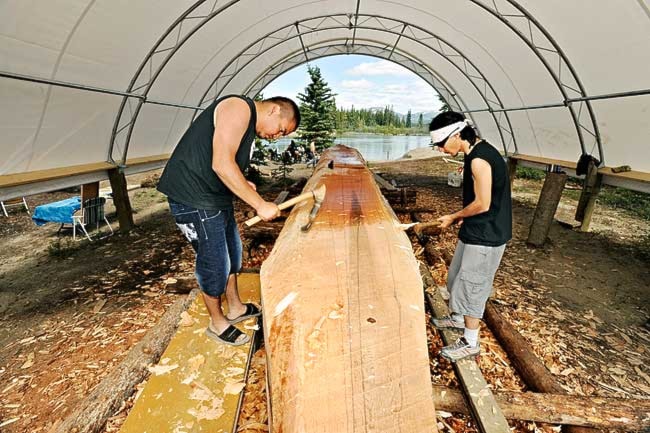The smell of sweat mixes with the sharp scent of red cedar.
Under a white canopy buzzing with horseflies and mosquitoes 18 youth take turns sculpting and whittling away at the body of a 350-year-old-tree.
In two months time the 5,900-kilogram hulk of British Columbia red cedar will be carved into a nine-metre dugout canoe fitting eight or nine people.
The inside will be dished out and the final shape, weighing in at 180 kilogram, will resemble a water balloon resting on a table.
“Majestic” is the only word Josh Lesage can find to describe what the canoe will look like once it’s finished.
Lesage is one of a group of youth who volunteered to unhook themselves from city life and camp out for two months on an island to learn the traditional Tlingit way of carving a dugout canoe.
“It’s a healing canoe,” said Lesage. “It’s more than just a project, it’s helping yourself find your purpose in life.”
On an island a half hour’s drive from Whitehorse, without television, cellphones and iPods, the youth focus on their carvings and on being healthy.
The 18 participants are all advanced carvers at Sundog Carving Studio. They will be living on Egg Island for eight weeks drug and alcohol free.
“Here my mind feels more pure,” said Lesage.
“Your thoughts come from what’s around you and when you’re in the city you have unnatural influences that corrupt your mind.”
The idea of a healing canoe is essential to Wayne Price, Tlingit master carver who is guiding the youth in building the canoe.
A couple years ago, Price carved a “healing totem pole” that he says was crucial in his own path to recovery.
He was struck by a vision six years ago while taking part in a sweat lodge ceremony.
“I realized then that the large gap that existed within my culture was that we had become removed from our artwork,” he said.
“I wanted to push to bring (my people) and our artwork closer together.”
As he stands watching 19-year-old Morgan Ayles carve the bottom of the canoe with an elbow adze (a sharp-angled chipping tool), he explains how the canoe represents a healing path for the mostly First Nation youth taking part in the project.
“Every chip that falls off the canoe represents a person who has been affected by alcohol or drugs,” he said.
All the cedar chips from the canoe will be saved and a felt-tip pen will be handed to each participant to write the name of someone they know who died as a result of using alcohol or drugs.
Price has been carving for the last 30 years, working on totem poles and canoes in Alaska, British Columbia and the Yukon. However, this is the first time that he’s ever guided a group of youth in carving a large project.
“It’s really rewarding to continue this kind of work through teaching,” said Price.
“I’m seeing lots of growth and good things happening with the youth.”
He’s also impressed at the speed at which the youth have been working. He says it would take him and another carver more than a month to complete what they’ve accomplished in the first week and a half of working.
The first two days were spent just hauling the wood up onto the island. It required all of the youth to carve out the river bank into a ramp. Using rollers they moved the 5,900 kilo log to where it now stands under a large, white canopy nine metres from the water.
“I’ve been looking for this life,” said Lesage who is unfazed by all the hard work. “I was getting sick of the city and needed a place to go.”
Lesage likes all the time he gets on the island to reflect on things in his life. A year and a half ago he moved to Whitehorse from a small town in Manitoba and says he quickly got pulled into a life of partying.
“It helps being out here to clear your mind,” he said.
Lesage says the group already feels like family and they are extremely supportive of one another.
“Some people recently lost their family members and it’s good that we can all be here for each other.”
The youth roll out of their tents at 7:30 a.m. each morning, eat a leisurely breakfast and begin a day of carving that lasts until 9 p.m.
Working on rotating two-hour shifts, all the youth get a chance to dig out the canoe. When they’re not chipping away at the canoe, they’re focusing on their own carving projects or playing music, writing and taking nature walks on the island.
The camp atmosphere is relaxed; a bonfire slowly burns in the middle of a cluster of lawn chairs and the sound of guitar strumming drifts above the island.
Each night the participants gather around the fire and tell stories to one another or sing traditional drumming songs.
“We’re singing some of the oldest songs I’ve ever heard,” said Lesage who, as the only non-First Nation youth at the camp, enjoys the culture he’s being steeped in.
“My favourite one is a Haida song that makes me think of peaceful moments.”
The youth will live on Egg Island until mid August and in addition to working on the canoe they’ll take part in talking circles and sweat lodges, and learn from Yukon elders.
Once the canoe is finished, it will be given to the Kwanlin Dun First Nation to be put on display at their new cultural centre on the Whitehorse waterfront.
Sundog is still looking for donations of food and money to finish funding the dugout canoe project.
Contact Vivian Belik at
vivianb@yukon-news.com
